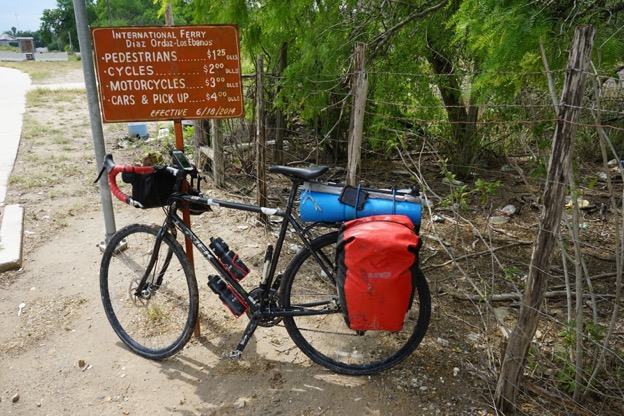I’m in America, but it feels like Mexico. Laredo is unique among border towns because it has always had a majority Latino population. Biking into the city you pass rows and rows and rows of warehouses, distribution centers, and yards full of semi-truck trailers before you hit this horrible commercial strip crammed full of every road-side corporate brand imaginable—McDonald’s, Starbucks, Burger King, Walmart, IHOP, Applebee’s—on and on, mile after mile.
It’s an awful stretch of road to confront as a “cyclist,” as we like to call ourselves in the biz, since you’re squarely in the crosshairs of the I-35 corridor, one of the biggest, meanest trucking corridors in the country. According to my out-of-date 2012 Texas guidebook, the I-35 and the I-10, which crosses east to west along the southern tier, carried $87 billion worth of goods to Mexico in 2011. Three million trucks cross from Mexico into Texas every year, and most of them go through Laredo. At the last stoplights leading out of the city, trucks were stacked three across and nine deep waiting for the light to turn green.
But eventually you reach the old city, and suddenly you’re in a different world. The streets are narrower, and all the signs are all in Spanish. People are running businesses like car washes and hat stores out of their homes.
In his 2011 book, American Nations, Colin Woodard argued that instead of red states vs. blue states, the country is divided into 11 separate cultural regions. These include “Yankeedom,” surrounding the Great Lakes; the “Deep South,” in all the obvious states; and “El Norte,” which stretches from San Diego to Brownsville, hovering just above the U.S.-Mexico border. I’ve seen evidence of Woodard’s map throughout this trip. Maybe this is obvious to everyone, but the idea that the border is its own thing, with its own people and culture, isolated from the American mainstream, is an ongoing revelation to me. I’m as close to San Antonio as I’m ever going to get, and it’s still three hours away by car. Many people here have never traveled that far north.
People here don’t fit neatly into the boxes assigned to them by American party politics. Frank Garcia, for example, the manager of the motel I stayed at in Del Rio, was born and raised in Brownsville, and has a lot of family in Mexico, but thinks building a wall on the border is a good idea. Frank served time in the U.S. Army and was deployed along two other far more infamous walls, the Berlin Wall and the DMZ.
“I think a wall is good as long as there are doors to let people in legally,” he says. Del Rio has a problem with teen pregnancy and a high college dropout rate, but Frank says he’s tired of watching generations of people take advantage of the government safety nets designed in response to those problems. Kids grow up along the border in small towns like Del Rio and most never leave.


